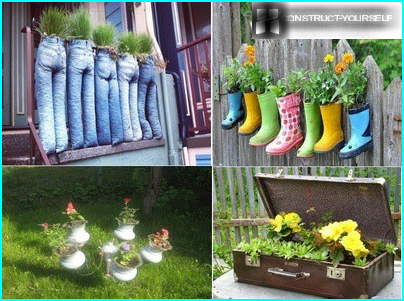
After the construction of houses and garbage disposal, it’s time to Refine the plot. I remembered a long-standing dream on the lawn – the lawn with green grass, without the vegetable patch. Just near the house remained free space, not occupied by agricultural land. It was decided to give a lawn. I started to read information on this topic, and then to plan the sequence in which to work, and what seeds to plant. Just want to say that the laying of the lawn – a matter of many months. Personally, I have all the stages from the start of excavation to the contemplation of good lawn, took about a year. Will tell you how it was with me – will share their experience, which I hope will help beginners «gazombadam» to avoid many mistakes.
The contents
Step 1. Seed selection and planning of works
After reviewing the information on the subject, I came to the conclusion that the best types of grass for lawn (in our terms) is the Kentucky bluegrass and red fescue. Started looking for a suitable grass mixture at the stores. In most compositions – definitely ryegrass, which in our climate is not ice. For a warm of Europe – excellent, suitable, but we have ryegrass freezes in winter, spring this lawn wakes up noticeably thinned. As a result, I stumbled upon a suitable monospecific mixture from cultivars of PoA pratensis True Blue Kentucky Bluegrass. The entire bluegrass lawn… Why not? Of course, the first year will have him carefully looked after, at first Moody bluegrass. But such a lawn with proper care is one of the most decorative. Resolved – a bluegrass lawn to be!
So, I bought seed bluegrass – 30% more than recommended by the manufacturer. This is important because part of the material may not germinate.
For itself deduced the following scheme of laying lawn:
- In the spring and summer preparing the ground: planning, cultivated, leveled, rolled down.
- In early August, spend herbicidal treatment, get rid of weeds.
- In late August – fertilize the soil and sow lawn. Caring for seedlings: watering, mowing, conduct weed control.
In this situation, that is, when sown in late summer, the lawn has time to grow and Mature before the cold weather. In the winter he leaves already formed, with a dense sod. And in the spring will look quite presentable.
This scheme I adhere to.
Step 2. Excavation work
Preparation of land for lawn I started in the spring, in April. This is probably the most difficult step, which determines the future appearance of the lawn. Work is being carried out in the following sequence: cultivation, leveling, compacting (tamping). Rolling and tamping, as a rule, repeated several times. That’s what I read on smart sites and what they had decided to follow unconditionally.
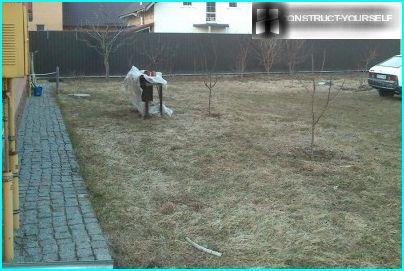
The site selected under the breakdown of the lawn
Initially, the soil on the site is a heavy clay loam. It seems to be good, but for the lawn, as I understand it, we need more loose earth. Therefore, to improve drainage and structure, I drove and scattered on a plot of peat and sand.
Were as follows: downstairs I have a bag of loam, and top with a mixture of sand and peat. To mix all the ingredients and get rid of the weeds, and I, with the cultivator, plough the land.
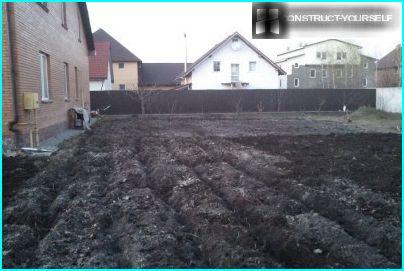
Plowing allows the cultivator to loosen the soil to make it homogeneous and to remove weeds
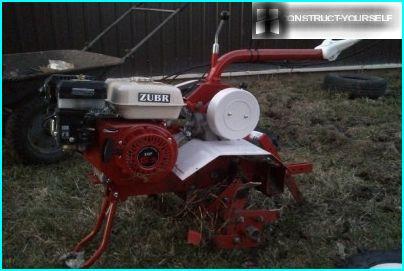
Such a cultivator was used for plowing the lawn area in
Now it was necessary to level the site. What? At first thought to rake, but my site is large – 5 acres, level lawn will not achieve. Decided to go the other way. Pulled out of the shed aluminum ladder 6 feet, strapped to the side of the rope.
Top for gravity put Gruz – channel with stones inside. It turned out something like the upgraded building by-laws, with whom I walked the area back and forth. Where you levelled, in some places spiked the earth. The process was controlled by a laser level.
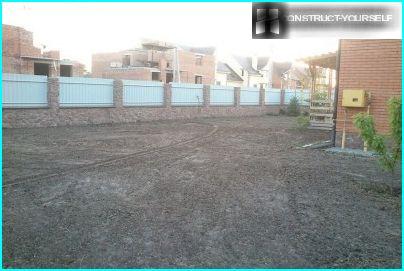
The alignment of the microrelief of the plot is an important component of the preparatory work for the establishment of lawn
After leveling paced roller. A good shed land. The process of levelling-tamping-watering is repeated many times within two months with the control level. By mid-summer, after rain, compacted at the site two hours later you can walk traces practically does not remain. Then I thought that this ground work can be completed.
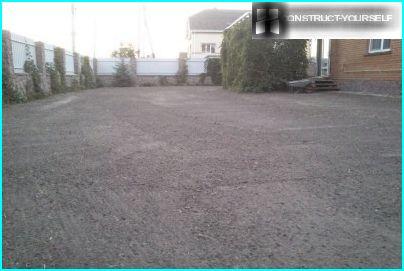
If the soil is compacted sufficiently, it should not be left deep traces when you walk
Step 3. Herbicidal treatment
Originally, I was against the use of herbicides. But… it Seems to be plowed ground, and during the summer constantly pulled pernicious weeds, but they grew and grew. The prospect of endless weeding was not pleased, especially as the seeding time is inexorably approaching. So I spilled rammed the platform, wait for weeds and protravel them «Roundup».
Then removed the dried grass. In two weeks you can begin crops. By the way, by this time, young weeds climbed again, but I quickly yanked on prepared soil, it is not difficult.
Step 4. Lawn fertilizing
As I understand it, some do not fertilize your lawn or fertilize them once a year, something long lasting. Such an approach is the place to be, but only on fertile soils where originally laid nutrients. The soil on my plot is not particularly nutritious, so I decided to go the traditional way and still fertilize before sowing.
At this stage, it is very useful seeder Texas, which not only scatter the seeds and granular fertilizers too. At first I had shed land, and then walked through it with the drill, made ammophos (content of nitrogen and phosphorus 12-52) – 2 kg per one hundred square meters, as well as potassium chloride – 0.5 kg per one hundred square meters. In the preplant fertilizer special attention to phosphorus. It accelerates seed germination and stimulates the development of root systems. Then, in primary care, the lawn will need other fertilizers.
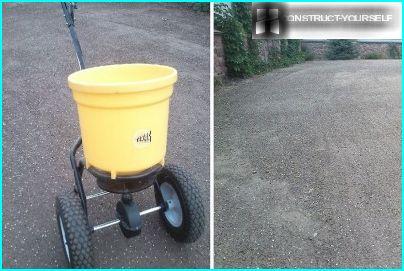
Fertilising before sowing grass seeds will speed up germination
After dispersal of the pellets I was harnessed to a small harrow and went to loosen the soil. Harrow – this is optional, you can rake to use.
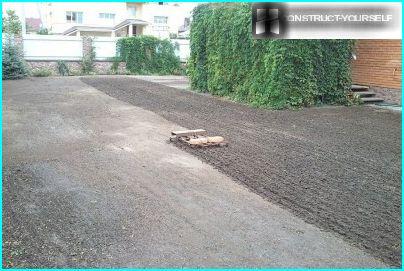
Loosening the soil before sowing seeds bluegrass
Step 5. Sowing seeds
Then came the sowing. I mixed the seeds with sand, then divided the whole volume of the mixture into two piles. Loaded seeder one portion, completed sowing in the longitudinal direction. The second portion of the seed went to the seed in the transverse direction. At the end, I went sown a rake to slightly seal the seeds in the ground. Not more than 1 cm, so as not washed away by rain or carried by wind.
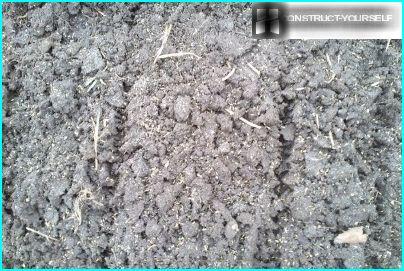
Lawn grass seeds can be a bit to close up, proryhliv soil with a rake
Just in case rolled crops roller. And began to wait for germination.
I would like to draw attention to the following. I timed the planting to the 20 th of August. At this time, as a rule, the searing heat is gone, begins the season of rains and cloudy weather. My lawn in this respect was lucky. After sowing stood cloudy, cool weather, it rained a lot, so watering before germination there was no need. If you choose a different time of sowing, for example, in early summer (actually, it is possible to sow a lawn from may to September), you will have to constantly make sure that the seeds do not dry. The soil should be constantly moist, only then seeds can germinate.
In the heat to water will be 2 to 4 times a day, otherwise the experiment with the lawn will have to give up – nothing will rise or will rise in some areas (where there was more moisture capacity of soil or in the shade). To somewhat simplify the task of watering, in the hot or dry season, it is desirable to cover the planted area with agro-fibre – «Spandex», «Agroprom» etc. Under material the seeds will be protected against loss of moisture, wind, hot sun. Therefore, under the agrotextile grass lawn rises faster than in open areas. However, once she’s ascended, «teplychku» it is recommended to remove. And to care for your lawn in the traditional mode.
Step 6. Care first sprouts
The first shoots of my bluegrass lawn appeared on the 10th day of sowing. It was a small, thin threads, the germination is uneven. Thought I would have to deceiving, but no. Late in a few days hatch and lagging seeds.
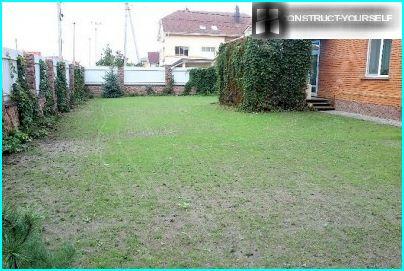
For young, newly vsosatsya the lawn, it is better not to move, not to trample small blades of grass
Just at this time came warming rains some time it was not. I put on plot sprayers and watered the young boring every day in the morning. Seedlings are very delicate, if they’re a little dry – all die. The land should be slightly vlazhnovatoy constantly, until the sprouts will not appear more or less developed root system. Judging from my experience, this occurs when the grass reaches 4-5 cm then you can relax a little. But just a little bit. Before the first mowing of the dry land could be detrimental to the lawn, he is very sensitive to drought.
I was really hoping that the cold will not come early and I have time to mow the lawn for the first time, to form a beautiful carpet and look at his handiwork in all its glory. And so it happened. After 3 weeks the grass has reached a height of about 8 cm, it was possible to mow. In the morning I had shed the lawn, took out the mower and go! No more cut off the top third of the grass so as not to damage the young plants. I liked the result: smooth, fairly thick Mat, nice colors. After mowing charged rains. Before winter I lawn is not watered and not mowed. Experiment and observation was continued lawn next spring.
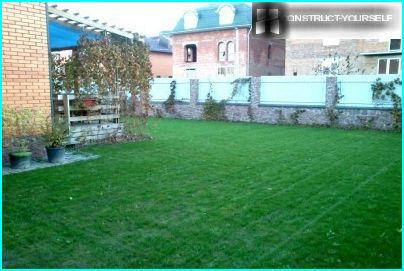
In October, the lawn was the first time wiscosin
Step 7. Activities for the care of young turf
In the spring, after the snow melts, the lawn sat a long time «without movement», probably because of the cold. How were small sprouts, and remained, the color is also left much to be desired – some grayish-yellow. But a half-forgotten weeds. At first I tried to pull them, and then protravel «Linuron». The weeds have long faces then they have been less – the lawn itself gradually forms a dense sod and displaces unwanted «neighbors». And the cutting on them is not acting in the best way.
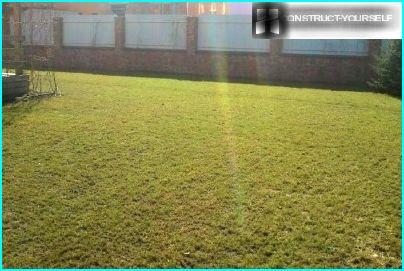
After the winter the color of the lawn leaves much to be desired
The visible growth of a lawn has begun, when the ground is sufficiently warmed, to a temperature of 10-15°C. you can Now see the result – the grass is perfectly formed, well survived the winter and grew stronger.
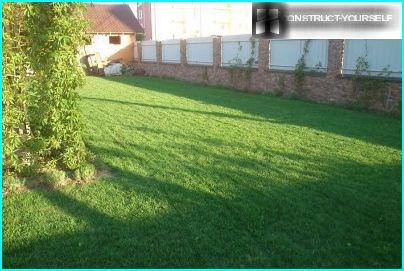
The grass has started to grow and green — may
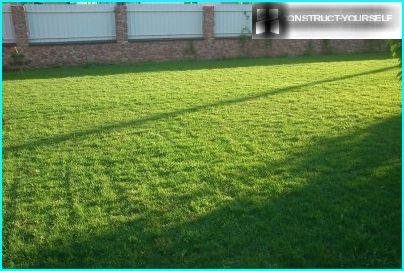
The bluegrass lawn is fully formed — June
Follow up care for the lawn I do so:
- Watered as needed. Not every day, but only after drying of the earth. Watering should be abundant, but rare. In the fall, before cold weather, it is better to refrain from watering or the lawn bad winter.
- Fertilizer. For my lawn I use a threefold scheme of feeding for the season, a total of 3 times with an interval of one month. Use any fertilizer for lawn grass with an exemplary combination of the main elements of the 4:1:2 (nitrogen, phosphorus, potassium).
- Mowing. In the second year of the life of the lawn, I went to a weekly mowing, each time cut off no more than a third of the length of the grass.
These rules help me to have a lawn in good condition. The result suits me, I think that the experiment with the turf, I have managed.
Peter K.






